Accepted Scientific Name: Duvaliandra dioscoridis (Lavranos) M.G.Gilbert
Cact. Succ. J. (Los Angeles) 52: 101 1980
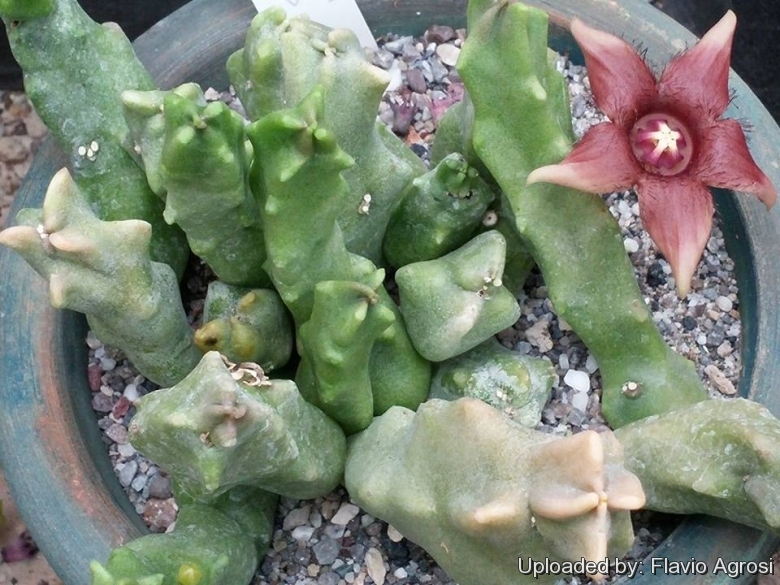
Caralluma dioscoridis (Duvaliandra dioscoridis) Photo by: Flavio Agrosi
Origin and Habitat: This small succulent is known only from a single locality where its estimated area of occupancy is extremely small (less than 100 m²). The site is at 900 metres above sea level on a granite outcrop in the relatively wet central mountains of Socotra, Adho-Dhemalu Island (Yemen) in the Indian Ocean. This is an unexpected place to find a succulent, however, its niche is specialised: dry, exposed, south to southeast facing slabs of granite. A search of likely habitats at similar altitudes in the mountains has failed to find further subpopulations.
Conservation status: Critically Endangered. The population is healthy and actively regenerating. However, due to the popularity of such plants with succulent enthusiasts, the low numbers of individuals (under 50) and the relative accessibility of the only known site, the plant is considered Critically Endangered.
Synonyms:
Description: Caralluma dioscoridis is a low succulent, suckering freely, forming large, dense, colonies up to 1 m across groups (not in cultication). It is a very rare Socotran endemic that shows a unique combination of Caralluma and Orbea / Duvalia / Whitesloanea features. It is believed that the similarity to Caralluma is through convergence and that its true relationships are nearer Orbea prognatha or Duvalia sulcata. In habit (when not in flower) it superficially resembles Caralluma europaca but the affinities (on the basis of stem form only) are significantly vague. The morphology of pollinaria and fruits indicates, as does the name, a relationship of Duvaliandra with Duvalia, while in stem morphology and biogeography, Whitesloanea appears to be much closer. On the other hand, corona, anthers and style head indicate that this Socotran endemic occupies an isolated position. Some authors guess it could be an old wild duvalia-caralluma hybrid.
Derivation of name: It was called “Duvaliandra” for the similarity to the genus Duvalia (Asclepiadaceae) and “discoridis” for the ancient name of Socotra which is "Dioscoridis Insula" (Island of Discorides).
Leaves: None.
Stems: Prostrate, decumbent to ascending, 4-angled. quadrangular in cross-section, 2-10 cm high, 1-1,7 cm thick, pale grey-green smooth, rooting were touching the soil. Tuberclers small, hardly protruding.
Inflorescence: Lateral (basal to almost apical), sessile or shortly and broadly pedunculate, with few minute bracts, mostly with one single flowers, or 2 or 3 flowered, but usually only 1 flower open at a time.
Flowers: Corolla rotate, 35-55mm diameter, very fleshy, outside pale green, inside flesh-coloured to brownish red, glossy, base of tube and tips of the lobes often yellowish to flesh-coloured, deeply lobed, covered with brownish-purple club-shaped hairs these about 2 mm long, simple, erect. Corolla tube 2-4 by 8-12 mm, bowl-shaped, basally papillate. Corolla lobes triangular pointed, 15-20 mm long 10-14 mm wide. Pedicel 5-30 long and 1.5-2.5 mm wide. Sepals triangular, acute, 2 - 4 mm glabrous. Corona apparently uniseriate, sessile, purple, lentil-shaped, 6-8 mm diameter, lobes trapezoid from a thickened and broadened base surrounding the style head.Anthers small, placed almost vertically on the short style head. Scent strong and foetid.
Fruits: Less than 6 cm long cylindrical, acute.
Bibliography: Major references and further lectures
1) Focke Albers, Ulrich Meve “Illustrated Handbook of Succulent Plants: Asclepiadaceae: Asclepiadaceae” Volume 4 Springer Science & Business Media, 2002
2) Anthony G. Miller, Miranda Morris “Ethnoflora of the Soqotra Archipelago” Royal Botanic Garden Edinburgh, 01/Jan/2004
3) Miller, A. 2004. Duvaliandra dioscoridis. The IUCN Red List of Threatened Species. Version 2014.2. <www.iucnredlist.org>. Downloaded on 28 October 2014.
4) Gilbert, Michael George. Cactus and Succulent Journal of Great Britain 42(4): 101 1980
5) Lavranos, John Jacob. Hooker's Icones Plantarum 37: t. 3687, p. 1.1972
6) Wikipedia contributors. "Duvaliandra." Wikipedia, The Free Encyclopedia. Wikipedia, The Free Encyclopedia, 13 Oct. 2014. Web. 28 Oct. 2014.
 Caralluma dioscoridis (Duvaliandra dioscoridis) Photo by: Giuseppe Distefano
Caralluma dioscoridis (Duvaliandra dioscoridis) Photo by: Giuseppe Distefano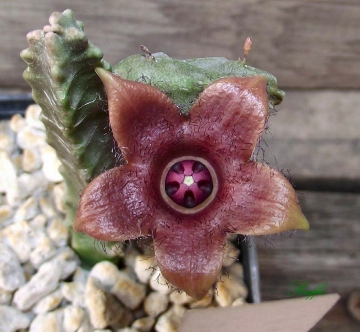 Caralluma dioscoridis (Duvaliandra dioscoridis) Photo by: Raffa C. Garcia
Caralluma dioscoridis (Duvaliandra dioscoridis) Photo by: Raffa C. Garcia Caralluma dioscoridis (Duvaliandra dioscoridis) Photo by: Giuseppe Distefano
Caralluma dioscoridis (Duvaliandra dioscoridis) Photo by: Giuseppe Distefano Caralluma dioscoridis (Duvaliandra dioscoridis) Photo by: Giuseppe Distefano
Caralluma dioscoridis (Duvaliandra dioscoridis) Photo by: Giuseppe Distefano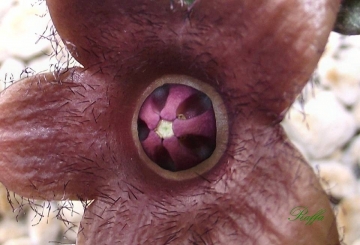 Caralluma dioscoridis (Duvaliandra dioscoridis) Photo by: Raffa C. Garcia
Caralluma dioscoridis (Duvaliandra dioscoridis) Photo by: Raffa C. Garcia Caralluma dioscoridis (Duvaliandra dioscoridis) Photo by: © Plantemania
Caralluma dioscoridis (Duvaliandra dioscoridis) Photo by: © Plantemania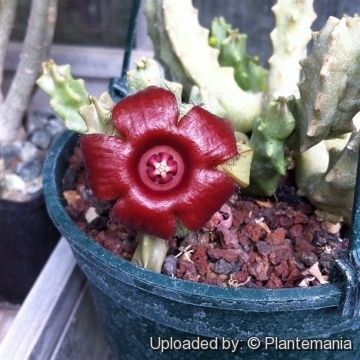 Caralluma dioscoridis (Duvaliandra dioscoridis) Photo by: © Plantemania
Caralluma dioscoridis (Duvaliandra dioscoridis) Photo by: © Plantemania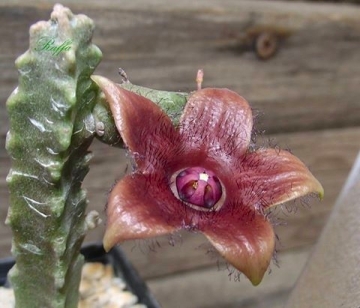 Caralluma dioscoridis (Duvaliandra dioscoridis) Photo by: Raffa C. Garcia
Caralluma dioscoridis (Duvaliandra dioscoridis) Photo by: Raffa C. GarciaCultivation and Propagation: Duvaliandra dioscoridisSN|29240]]SN|29240]] is a particularly difficult plant to keep because of its very specific growing needs with much light and relatively high (above 15°C) winter temperatures. It’s very susceptible to rot in combination with low temperatures, but given the right growing conditions it is an easy blooming plant. The goal with this plant is to grow it as fast as possible in the heat and full sun of summer (lots of water!) and hope for flowers the first or second season and then try to keep it alive during winter with lighter, but regular watering. Pieces of stems may be used to start new plants, so it is worth a try!
Watering: It require moderately watering through the growing season but enjoy plenty of water and some fertiliser in hot weather and allow them to dry before watering again, this helps them to flower freely. Water sparingly in winter according to temperatures. But, as with most asclepiads, it is unwise to leave them wet in cold weather. Winter care presents no problems at 15°C with plenty of light. Since roots are quite shallow, use a cactus mix or add extra perlite or pumice to regular soil potting soil. A gritty, very free-draining compost is suitable, and clay pots help the plants to dry out between watering.
Sun Exposure: Partial sun or light shade
Pest and diseases: They are very susceptible to stem and root mealy bugs, and damage from these may well initiate fungal attack. If you do have problems with a stem or with basal rotting, you can reliably isolate the healthy parts, dry them off, and re-root them in moist compost.
Cultural Practices: Re-pot every 2 years.
Propagation: Easiest with stem cuttings. Allow cuttings to dry a day before planting. Stems must be laid (Not buried) on gritty compost and will then root from the underside of the stems. It can also be increased from seeds sowing in spring in moist, sandy peat moss.
Potting medium: Since roots are quite shallow, use a cactus mix or add extra perlite or pumice to regular soil potting soil. A gritty, very free-draining compost is suitable, and clay pots help the plants to dry out between watering.


















